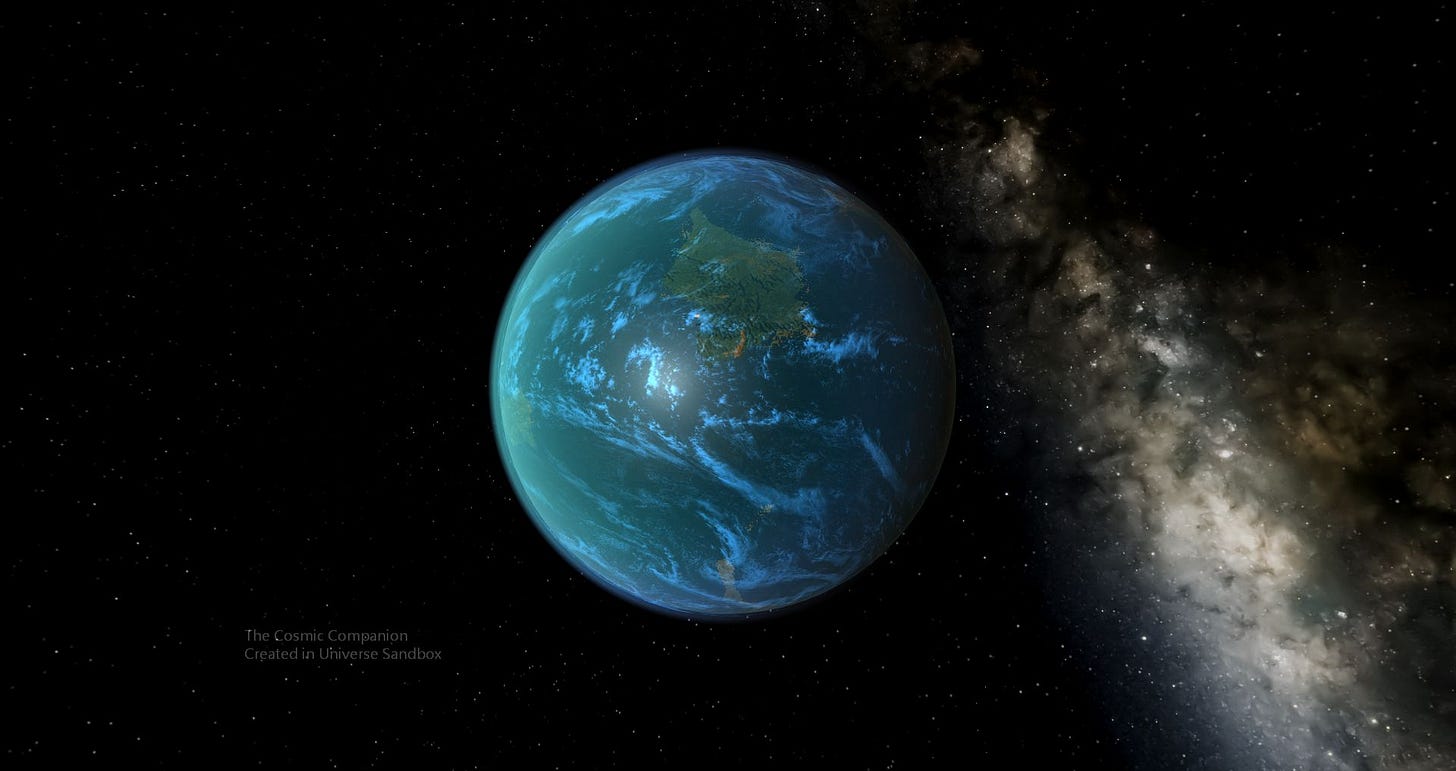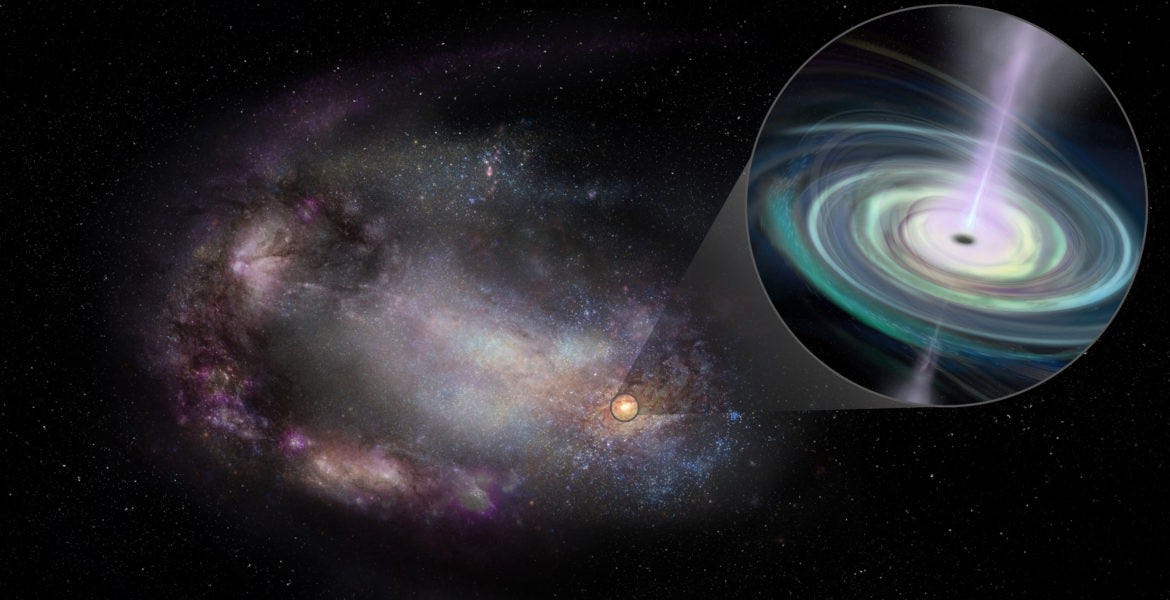The Cosmic Companion January 11, 2020
Happy 2020! We are off to a rousing start - black holes, exoplanets, and Mars!
Hello everyone!
Happy new year, and I wish everyone an exciting, wonderful year. This week is full of incredible stories, including the search for oxygen on alien worlds, new data about black holes, and Mars is losing water faster than anyone expected.
Listen and subscribe to Astronomy News with The Cosmic Companion through any major podcast provider, including iTunes, Spotify, or TuneIn! Or, listen in at: https://thecosmiccompanion.substack.com.
The Cosmic Companion also offers a premium newsletter, featuring weekly exclusive videos, the astronomy comic of the week, and more. Just $5 a month, or $50 a year! Sign up at: https://thecosmiccompanion.substack.com.
Or, you can buy me a cup of coffee for my work!
Let’s take off!
The Week in Space
How The James Webb Space Telescope will See Oxygen in Alien Atmospheres
By James Maynard
As astronomers examine the atmospheres of planets orbiting other stars, a new method of detecting oxygen, developed at the University of California Riverside, could provide evidence for worlds that may harbor life.

Astronomers may soon be able to detect oxygen in the atmospheres of distant exoplanets. This could be the signs of life — or heating that could doom large water worlds like this one. Image credit: Simulation by The Cosmic Companion/Created in Universe Sandbox.
Astronomers know of more than 4,000 planets orbiting stars other than our own Sun. However, examining the atmospheres of these worlds is at the very limits of what astronomers are capable of carrying out.
However, the James Webb Space Telescope, due for launch in March 2021, will have the ability to determine the chemical composition of these alien atmospheres. Signs of large quantities of oxygen in the air of alien worlds could, potentially, be a sign of life.
New research from the University of California Riverside suggests that the Webb Telescope could find oxygen surrounding distant exoplanets by studying patterns in how these molecules block light. Using this method, astronomers may be able to easily detect oxygen in the atmospheres of distant worlds.
Read more: http://bit.ly/James-Webb-Oxygen-Atmospheres
‘Wandering’ Black Holes Found in Dwarf Galaxies
By Rob Lea
Newly discovered massive black holes located away from the centre of their respective galaxies may give us vital clues about how black holes formed in the early Universe.

Artist’s conception of a dwarf galaxy, its shape distorted, most likely by a past interaction with another galaxy, and a massive black hole in its outskirts (pullout). The black hole is drawing in material that forms a rotating accretion disc and generates jets of material propelled outward. Image credit: Sophia Dagnello, NRAO/AUI/NSF
A recent discovery of 13 massive black holes at the centers of dwarf galaxies could aid astronomers seeking to understand how black holes formed in the early Universe. Each of these galaxies is less than one percent as large as the Milky Way, and the black holes they contain hold roughly 400,000 times as much mass as the Sun.
By studying these black holes, researchers at Montana State University found that these black holes could form, even as their host galaxies underwent periods of vigorous star formation. This unexpected result shows that the earliest galaxies were also capable of forming similar black holes when the Universe was young.
Read more: http://bit.ly/Wandering-Black-Holes
Exoplanet Found by TESS Orbiting a Pair of Stars Like Tatooine
By James Maynard
NASA’s Transiting Exoplanet Survey Satellite (TESS) spies a planet with a pair of suns, similar to the home world of Luke Skywalker from Star Wars. In future years, 100 more planets like this world may be found.

A simulation showing how KOI-1338 may look as it orbits its pair of suns. Image credit: Screenshot from video created by NASA Goddard.
Using the new TESS spacecraft, launched in 2018, astronomers have found a planet orbiting a pair of stars in the TOI-1338 star system.
Most stars are accompanied by one or more stellar partners, so binary star systems are fairly common. However, it is challenging to find planets in these families of stars, due to the complex gravitational attractions in such systems. The now-defunct Kepler spacecraft found 12 of these worlds, and TESS is expected to find 100 more during the course of its mission.
Read more: http://bit.ly/Exoplanet-TESS-Tatooine
Water Vapor Seen Rapidly Escaping From Mars
By James Maynard
Already a desert planet, Mars is still losing the water it has left at a far greater speed than astronomers expected. Researchers from the French National Centre for Scientific Research think they know what’s happening.

Mars was once a water world (right), but turned to desert billions of years in the past. Today, water loss continues at a far greater pace than astronomers expected. Image credit: NASA’s Goddard Space Flight Center
Billions of years ago, Mars was a world with oceans, rivers, and ponds. The loss of its magnetic field left the world a barren desert. Still, some water remains on Mars, found at both poles, and underground.
However, a new finding shows that as summer comes to each hemisphere of the Red Planet, water driven into the atmosphere can escape to space much more quickly than previously believed. Several spacecraft are due for launch to Mars during the upcoming year.
Read more: http://bit.ly/Water-Escaping-from-Mars
Read more stories at www.thecosmiccompanion.com

Coming soon: The First Woman on the Moon: The Past and Future History of Women in Space by James Maynard
Thanks for reading!
The new year will offer several upcoming changes for The Cosmic Companion, including new and exciting features, articles, comic strips, and more.
You can also listen to my new podcast, Astronomy News with The Cosmic Companion, available on all major podcast distributors, including iTunes, Spotify, and TuneIn! Or, tune in at: https://thecosmiccompanion.substack.com. You can also now add Astronomy News with The Cosmic Companion to your flash briefings on Amazon Alexa!
If you want to keep up with the latest updates and news about astronomy and space exploration, visit www.thecosmiccompanion.com, join my Facebook page, subscribe on YouTube, and follow @TheCosmicCompanion on Instagram and @CompanionCosmic on Twitter.
Remember - VIP subscribers receive this newsletter, plus a second weekly newsletter with sneak previews of each video episode of Astronomy News with The Cosmic Companion, an astronomy comic of the week, rare space photos, and more! Plans start at just $5!
Do you know someone else who would love this newsletter? Please share! Invest in knowledge with a premium subscription for yourself or a loved one today (including advance viewings of my weekly video show)! Or, I’d love it if you could buy me a cup of coffee - I LOVE coffee!
Thanks, and happy holidays — see you on January 11th!
Astronomy - Don’t Leave Home Without It!
- James


